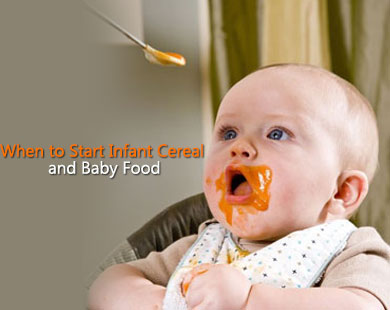It is important to know that at 4 months of age your baby should be ready to
begin solids. Start by introducing cereal into your baby’s diet but use only
single grain cereals. Those are rice, barley, and oatmeal. You could try each
new cereal for 3-4 days before starting the next one. You should use cereals
that are high in iron and vitamins. Avoid using cereal that comes mixed with
formula because formula may be different than the one your baby takes. Moreover,
the cereal may be a mixture of grains. That is why you should start with one
teaspoon of dry cereal and mix it with one ounce of formula once a day.
Gradually increase the dry cereal to three tablespoons, and then to three
tablespoons twice a day, the best is at the morning and evening.
Make sure the cereal is thin and runny at first, as the baby will be unused to
the texture of thick cereal and do not aid sugar, honey, syrup or salt to the
baby’s cereal. The baby does not know the difference so do not aid it. They
watch and open their mouth for the spoon, and does not push food out with their
tongue. You should not offer your child high-nitrate vegetables such as beets,
broccoli, carrots, cauliflower, green beans, spinach and turnips, until after 6
months of age. The best is to let your baby decide how much to eat.
When feeding your baby, look for signs of hunger and fullness, the way your baby
will shut their mouth, turn their head, or push food away when they have had
enough to eat. You should not force your baby to eat more when they have had
enough. Babies who are still hungry will continue to open their mouths for food
and may be upset when the food is taken away of him or her. It is the best to
offer one new food at a time. Try to wait at least 3 days before adding another
new food and do not put cereal or other solids in a bottle.
From Birth to Six Months of Age
Breast milk is the best food for your baby so babies who are not breastfed
should be offered iron-fortified infant formula. It is important to know that
babies do not need solid foods until they are 6 months of age. Breastfed babies
need 400 IU of vitamin D each day from a vitamin supplement so formula fed
babies can get enough vitamin D from formula. If your baby drinks both breast
milk and formula, ask a dietitian if they need a vitamin D supplement or not.
The answer is because at 6 months old your baby needs more nutrients, especially
iron. Your baby needs to try different tastes and textures, and most babies are
ready for solid foods. Signs of babies readiness include when baby sits and
holds their head up.
From Six to Nine Months of Age
Continue to breastfeed or offer iron-fortified infant formula. Do it whenever
your baby is hungry - about 720 -1250 ml each day. As your baby eats more
solids, they will gradually drink less breast milk or formula then they used to.
Sips of water may be offered in a cup, but you should not let your baby fill up
on water. You should also know that your baby does not need juice. If offering
juice, limit to 60 ml or 1/4 cup per day. It is the best way to serve it in a
cup. When starting solids, choose a time when baby is content, interested and
alert and begin by offering solids 1-2 times per day and increase to 3-4 times
per day. It would be nice if you could sit down and eat with your baby. Start
with small amounts of high iron foods like iron-fortified infant cereal or
well-cooked finely minced meat, poultry or fish, mix with breast milk, formula,
or water. You could also use a single-grain iron-fortified infant cereal to
start with. Try to gradually increase cereal to about 60-125 ml each day. If
your baby does not eat meat, aim for at least 125 ml of cereal, on average, each
day by 9 months of age. You should also offer cooked, well-mashed vegetables
like yams, sweet potatoes, potatoes, squash, carrots, and mashed fruit like
pears, peaches, and bananas. Start with small amounts and gradually increase to
about 60-125 ml per day. Continue to offer meat, poultry and fish, while adding
other high iron foods like cooked egg yolk, lentils, beans, and tofu. Add about
100 ml total per day. Around time when your baby is nine months old, try cottage
cheese, plain yogurt, and pasteurized cheeses.
Pureed foods are not needed, but baby can enjoy mashed foods and finger foods
before teeth appear. Offer finger foods such as pieces of cooked vegetables or
soft fruit without the peel, like potato, yam, avocado, apricot, pear, banana,
peach, plum. You could also offer strips of toast, cooked rice, cooked pasta,
and oat rings cereal.
From 9 to 12 Months of Age
Breast milk or iron-fortified formula, about 625-950 ml per day, and water in a
cup are something your baby definitely needs. Your baby does not need juice, so
if offering juice, limit to 125 ml per day, served in a cup. Offer 100 per cent
juice only and do not let your baby sip on juice or diluted juice often during
the day. This can cause tooth decay. Try to offer foods 5-6 times per day and
offer solid foods before breast or formula feeding. Iron-fortified infant
cereal, about 125 ml or more per day and meat, fish, poultry, cooked egg yolk,
lentils, beans, and tofu are important. Soft vegetables and fruit are also
recommended to include into baby’s nutrition from 9 to 12 months. You could also
try with soft, diced family foods, but let your baby feed themselves, with
fingers or a spoon. By 1 year, your baby should be eating the same meals as the
rest of the family, except foods that may cause choking. Health professionals
recommend that egg white not be given to babies until 1 year to lower the chance
of an allergic reaction baby could develop.
What About Cow’s Milk?
Breastfeeding is recommended until your baby is 2 years old and longer so when
your baby is 9-12 months old and taking a variety of solid foods, it is okay to
offer small amounts of whole milk. Whole milk may be substituted for breast milk
or formula when your baby is 1 or more year old. Babies and toddlers need fat in
their diets for brain development. That is why, choose whole milk until age of
two years. Lower-fat milk can be offered after that age. Other drinks such as
soy or rice beverages may be offered after baby is two years old, but check the
label to make sure they are fortified with calcium and vitamin D. If you choose
whole goat milk, make sure it is pasteurized, and since most goat milk does not
contain vitamin D, in which case your baby would need a vitamin D supplement.
Fruit Juice
Fruit juices may be introduced at 4 months, but do not introduce a new juice the
same day as a new food. Vitamin C fortified and no sugar added infant juices are
an excellent source of vitamin C for baby. Start with single ingredient juices
of apple, grape and pear. You should not start the citrus juices such as orange
and grapefruit until 6 months, as these are not tolerated well. It is very
important for you to know not to give soda, fruit punch, fruit drinks, or kool
aid. You must know these are not fruit juices. They are mostly food coloring,
sugar, and water, so read the label to be sure that juice is the first
ingredient and avoid juice with added sugar. Your baby’s stools will change with
the introduction of new foods so you should not be worried about that.
Introducing Vegetables and Fruits
You have probably heard that it is better to offer vegetables before offering
fruit to your baby. The reason is that fruit is sweeter, so your baby may not
accept vegetables if they are started after fruit. Start with the orange
vegetables first as well with carrots, squash, sweet potatoes, then try green
vegetables such as peas and green beans. Try one new vegetable for 3-4 days
before starting another one. Start with one to three teaspoons once a day. You
could gradually increase this to four tablespoons a day. Once the baby is doing
well with vegetables, you may add fruits to its nutrition. Start with plain,
single ingredient fruits such as bananas, applesauce, pears, apricot, peaches or
plums, around one to three teaspoons once a day. Gradually increase this to four
tablespoons, but do not feed the baby directly from the jar. Take out the amount
needed for a feeding and put it in a dish, and cover the jar of leftover baby
food and refrigerate it immediately. This will avoid spoiling the rest of the
jar, so that one jar of baby food can be used few days, not more then three. Do
not add salt, sugar, honey or spices to baby foods and never give honey to a
baby less than 1 year old. The reason is that honey can give a baby Botulism, a
type of food poisoning that can cause death. Help your baby develop healthy food
habits and a relaxed feeling about eating, so offer appropriate food at regular
times. Sit down and eat with your child because babies and children enjoy
company while eating. You decide what foods to offer but let your baby decide
how much and whether to eat.
Safety Tips
Always stay with your baby while he or she is eating or drinking and avoid foods
that can cause choking such as popcorn, peanuts, nuts, hard candies, carrots.
Try to avoid other hard raw vegetables, whole marshmallows, jellybeans, globs of
peanut butter, ice cubes, and chips. Hot dogs and grapes should be sliced
lengthwise first, then into small pieces, while milk, juice, and soft cheese,
such as feta, brie and camembert should be pasteurized. Feed only breast milk or
infant formula until your baby is 4 months old and at 4 months of age, you may
begin to introduce solid foods. Start with the single grain iron-fortified
cereals such as rice, barley and oatmeal. Next you may start orange vegetables,
then green vegetables and fruits should be introduced last.
* Written by steadyhealth.com




















